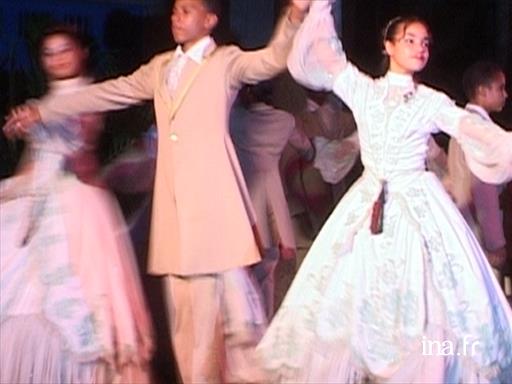Habanera, history of Cuban dances

Information
Iliana Garcia performs a contradance by Mozart to demonstrate its rhythmic similarities with habanera
Context
This beautiful documentary presents the essence of this dance, which is also a music, a rhythm and its own culture all rolled into one. Here, we can still see a 2x3 step system, alternating left and right. Now all you need to do is to listen to the music; the explanations given by the pianist are especially accurate.
Without wanting to complicate matters too much, remember that the first rhythm to combine two different lengths is the Greek anapest: the famous "quick-quick-slow". This is the basis of polka, which was also exported, of course. This rhythm can easily be seen in the habanera. Musically speaking, it is more difficult, because the two so-called «quick» sounds are not the same length, there is a clearly something that has been «mixed» with polka's simple rhythm, affecting the two «quick» sounds, as if it already were becoming a «swing».
You can clearly hear a rhythm which goes: ' pom, ti-ti, pom ", called the milonga rhythm by theorists, [stressing: mi, lon - ga, (and)]. While its little brother, the habanera rhythm goes: ' ti-ti, ti-ti, pom» [stressing: ha - ba, do-ra, (and)].
Polka: 
Milonga: 
Habanera: 
Samba: 
It is easy to understand that all these rhythmic patterns, which are so similar to one another, came to be intermixed, exchanged and enhanced with one other, and anyone would have to be extremely clever to be able to pinpoint an exact origin in time and space. It is also very easy to identify them in other countries. Because, of course, these moves and these rhythms travelled, for example, with sailors from the Caribbean, and they migrated, first to Brazil, which bestowed it with the characteristic rhythm of the samba by mixing with other typical Brazilian sounds; then, to Buenos Aires, where other fusions and hybridizations took place, which we will see later.
Finally, it would not possible to talk about this large family of Afro-Cuban rhythms without mentioning something about the clavé, a word that refers both to an instrument made with two small wooden cylinders, and the favourite rhythm the Cubans obtained from it. The slaves who worked in the ports and who were deprived of opportunities to make music appropriated wooden plugs which allowed them to assemble wooden crates, which they could make "sing". And this is how the clavé was born, in two-halves: the bottom half was ingeniously coiled above the palm and acted as a sound box while the top clave gently tapped on the bottom half to make it sing. Despite its small size, this instrument can be heard from very far away. And it is extremely characteristic.
The Cubans who never stopped creating rhythms with these two pieces of wood, obviously used habanera, and milonga rhythms, and created others which were exported throughout the world. In particular, the most well-known clavé rhythm, which was merely a development of the milonga-habanera rhythm, insofar as the two sounds are grouped together to create a syncopation, but in duple metre: the first creates the syncopation , while the second one uses that of the Polka to soften the rhythm And several variants of this basic clave rhythm spread.
Clave rhythm: 
Finally, we could also quote one other «child» of milonga-habanera, the cinquillo rhythm: 
The danzón was the national dance of Havana as early as 1880, until Cuban son came to dethrone it at the end of the 1920s. And there could be no important celebration without a danzón or a son being created for the occasion.
Finally, do not forget that a Frenchman, "Mr Pierre» (Zurchir-Majd) and his English partner Doris Lavelle came to fame for their French research on mid-20th century Cuban dances. They worked in Cuba with Pepe and Suzy Riviera, famous dancers, and brought back dance techniques used in dances like rumba and cha-cha-cha to Europe. It was there that they named the most common figures, figures that still have the same names in dance classes today.
Important note: what Europeans call "rumba", as do the Americans, who were the inventors of this terminology (they even wrote it: "rhumba"), is from the point of view of dance: Cuban son; and from the musical point of view, Bolero. It didn't seem to matter that Cubans didn't have a dance, let alone dances, in their culture with such a name. There are three things called the rumba in Cuba: cumbia, guaguanco and the Columbia River. And none of them is a closed couple dance, nor a ballroom dance! Now, everyone can make the difference between which dances have come about from the intermixing of existing styles and sounds and those that are merely products of commercial recycling, which Europe also saw in 1989 with the lambada.





